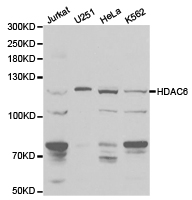HDAC6 Rabbit Polyclonal Antibody
Frequently bought together (3)
Transient overexpression lysate of histone deacetylase 6 (HDAC6)
USD 396.00
Other products for "HDAC6"
Specifications
| Product Data | |
| Applications | IHC, WB |
| Recommended Dilution | WB 1:500 - 1:2000;IHC 1:50- 1:200 |
| Reactivities | Human, Mouse, Rat |
| Host | Rabbit |
| Isotype | IgG |
| Clonality | Polyclonal |
| Immunogen | Recombinant protein of human HDAC6 |
| Formulation | Store at -20C or -80C. Avoid freeze / thaw cycles. Buffer: PBS with 0.02% sodium azide, 50% glycerol, pH7.3 |
| Concentration | lot specific |
| Purification | Affinity purification |
| Conjugation | Unconjugated |
| Storage | Store at -20°C as received. |
| Stability | Stable for 12 months from date of receipt. |
| Gene Name | histone deacetylase 6 |
| Database Link | |
| Background | HDAC6 is a class II histone deacetylase enzyme localized to the cytoplasm and associated with the microtubule network. It is involved in the regulation of many cellular processes, including cell migration, immune synapse formation, viral infection, and degradation of misfolded proteins. HDAC6 contains two tandem catalytic domains that facilitate the deacetylation of multiple protein substrates, including histones and non-histone proteins such as tubulin, cortactin, and HSP90. Despite the ability to deacetylate histone proteins in vitro, there is no evidence for HDAC6-mediated deacetylation of histones in vivo. The acetylation/deacetylation of tubulin on Lys40 regulates binding and motility of the kinesin-1 motor protein and subsequent transport of cargo proteins such as JNK-interacting protein 1 (JIP1). The acetylation/deacetylation of cortactin regulates cell motility by modulating the binding of cortactin to F-actin. Acetylation/deacetylation of HSP90 modulates chaperone complex activity by regulating the binding of an essential cochaperone protein, p23. In addition to its role as a protein deacetylase, HDAC6 functions as a component of the aggresome, a proteinaceous inclusion body that forms in response to an accumulation of misfolded or partially denatured proteins . Formation of the aggresome is a protective response that sequesters cytotoxic protein aggregates for eventual autophagic clearance from the cell. HDAC6 contains a zinc finger ubiquitin-binding domain that binds both mono- and poly-ubiquitinated proteins. HDAC6 binds to both poly-ubiquitinated misfolded proteins and dynein motors, facilitating the transport of misfolded proteins to the aggresome. HDAC6 is also required for subsequent recruitment of the autophagic machinery and clearance of aggresomes from the cell. Thus, HDAC6 plays a key role in the protection against the deleterious effects of pathological protein aggregation that occurs in various diseases, such as neurodegenerative Huntington’s disease. |
| Synonyms | CPBHM; HD6; JM21; PPP1R90 |
| Reference Data | |
| Protein Families | Druggable Genome, Transcription Factors |
Documents
| Product Manuals |
| FAQs |
| SDS |
{0} Product Review(s)
0 Product Review(s)
Submit review
Be the first one to submit a review
Product Citations
*Delivery time may vary from web posted schedule. Occasional delays may occur due to unforeseen
complexities in the preparation of your product. International customers may expect an additional 1-2 weeks
in shipping.






























































































































































































































































 Germany
Germany
 Japan
Japan
 United Kingdom
United Kingdom
 China
China



